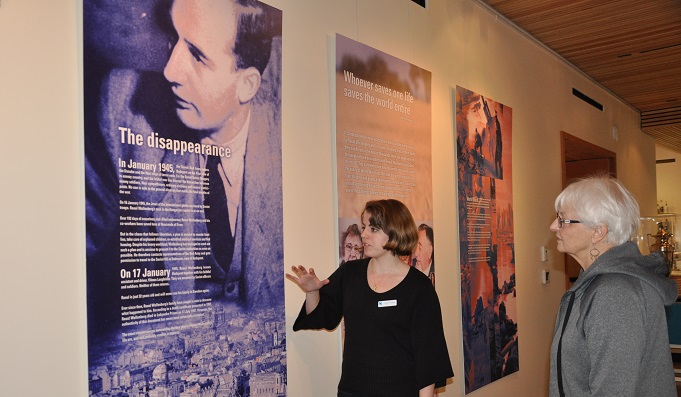
PHOTO: Nordia House Exhibit Director Chaney Harter explains a panel in the exhibit to a visitor. The exhibit runs through March 30. Photo by Deborah Moon
In just six months Swedish diplomat Raoul Wallenberg saved thousands of Hungarian Jews from the Nazis before he himself disappeared. A new exhibit in Portland (see below) provides the historic and personal context to understand a remarkable man and the horrendous situation he found when he accepted the Swedish diplomatic post in Budapest.
“This story requires a lot of context to understand the magnitude of what Raoul Wallenberg did,” says Nordia House exhibit director Chaney Harter.
The 14-panel exhibit at Nordia House in Southwest Portland includes Wallenberg’s birth shortly after his father died of cancer, his education at the University of Michigan, and his early career in South Africa and pre-state Israel. Other panels present the situation in Budapest, background on the Holocaust, the actions Wallenberg took in Budapest and his disappearance.
In addition to the exhibit, Nordia House is hosting programs to provide additional context. The opening celebration of the exhibit in February featured presentations by April Slabosheski, Holocaust educator at the Oregon Jewish Museum and Center for Holocaust Education, and Leslie and Eva Aigner. Both Leslie and Eva lived in Budapest before the war, survived the Holocaust, made their home in the Portland area and are part of OJMCHE’s Speakers’ Bureau. A lecture is planned in early March featuring Natan Meir, who is the Lorry I. Lokey Chair in Judaic Studies at Portland State University.
“Historically during times of persecution and oppression, and especially with the use of fear and violence that was so present during the Holocaust, we see bystanders’ values slowly changing and people becoming less likely to intervene when atrocity is taking place,” says April.
“Something I admire about Wallenberg, and the decision of the Swedish Ministry for Foreign Affairs to send him to Budapest, is their strong sense of certainty, selflessness and determination that the persecution of Hungarian Jews was unjust and that something must be done to help.”
Wallenberg gave thousands of Jews Protective Passports, which gave them temporary Swedish citizenship. Chaney says there are reports of Wallenberg arriving at train stations as transports were leaving for the death camps and writing out passports and pulling people off the trains. She said he would arrive at the depot with a list of Swedish “citizens” to give the Nazis and would add names to the list on the spot.
Wallenberg also rented dozens of buildings in Budapest and declared them Swedish territory. “People lived in these Wallenberg Houses,” says Chaney. Since no precise records were kept, the number of those he saved is uncertain, but estimates range from 15,000 to 30,000. Among the “Wallenberg survivors” were biochemist Lars Ernster and U.S. Rep. Tom Lantos.
April adds, “Wallenberg’s actions remind us that there are methods for intervening when persecution is taking place and offer an example of a time when intervention saved tens of thousands of lives. I think this is of critical importance today, as atrocities continue to take place and we often find ourselves wondering what can be done to help.”
Though both the Nazis and the Hungarian fascists opposed Wallenberg, he disappeared when he and his driver went to a meeting with the Soviets, whose army was approaching the city. Unconfirmed reports indicate he died in Siberia in the 1950s.
The exhibit was created by the Swedish Institute in Stockholm and is sponsored locally by Barry and Darlene Peterson and EPrint, which printed the panels from the digital images provided by the institute. Nordia House will keep the panels and plans to share them with other West Coast venues that want to present the exhibit.
Sandra Nelson Miller, Nordia House interim executive director, says she was excited about the opportunity to participate. “This exhibit is a wonderful reminder about how to think about resistance and how cruel people can be to one another.”
Nordia House is the cultural center of the Scandinavian organization Nordic Northwest, whose mission is to celebrate the contributions of the Nordic countries to the world.
“We have always wanted to share the story of Raoul Wallenberg,” says Chaney. “It is one of those stories that give you faith in humanity and makes you want to be braver and stand up for your values.”
“May we all have a little bit of Raoul Wallenberg in us.”
Raoul Wallenberg: To Me There’s No Other Choice
WHAT: Exhibit about Swedish diplomat Raoul Wallenberg, who saved thousands of Jews in Budapest in 1944.
EXHIBIT: 9 am-5 pm through March 30
PROGRAMS: Les and Eva Aigner, Holocaust survivors who lived in Budapest, share their story, March 4
PSU Judaic Studies Professor Natan Meir, March 7
WHERE: Nordia House, 8800 SW Oleson Road, Portland
INFORMATION: scanheritage.org | 503-977-0275
ADMISSION: Free





